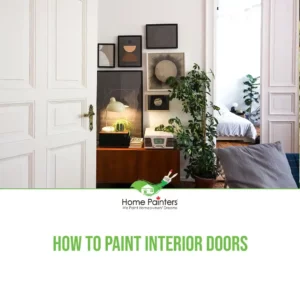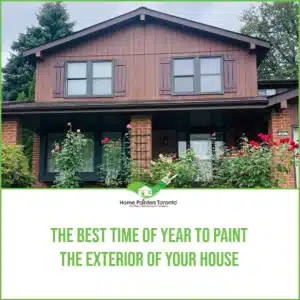
Interior doors are not only completely functional and necessary, but they can actually add unique touches to a room. Sure, a lot of us tend to think of doors as large wooden contraptions that simply divide rooms and block noise. But unique interior door painting and choosing your own style can be used to add so much more than that to a room!
There are actually a lot of different interior door styles to choose from when you really get down to it. Plus, there are so many on trend colours that can really work to give an unexpected pop to a space! So, let’s dig right into interior door painting: different styles & updating colour!
Understanding the Spectrum of Interior Door Styles
Interior doors come in a diverse array of styles, each carrying distinct design connotations. For instance, panel doors, with their traditional raised or recessed panels, evoke a sense of classic elegance that can anchor a space with a time-honoured aesthetic. Flush doors, on the other hand, offer a sleek, minimalist look that can be the perfect backdrop for modernist or contemporary settings. Glazed doors introduce glass elements, welcoming light flow and visual connectivity between rooms—a fine choice for enclaves requiring an airy ambiance.
The style of your door will influence your choice of colour and technique. For example, a solid colour works exceptionally well on panel doors, highlighting the depth and craftsmanship of the panels. A glazed door, meanwhile, can be framed with a bold colour to accentuate its transparency and the interplay of light.
Popular Interior Door Colours
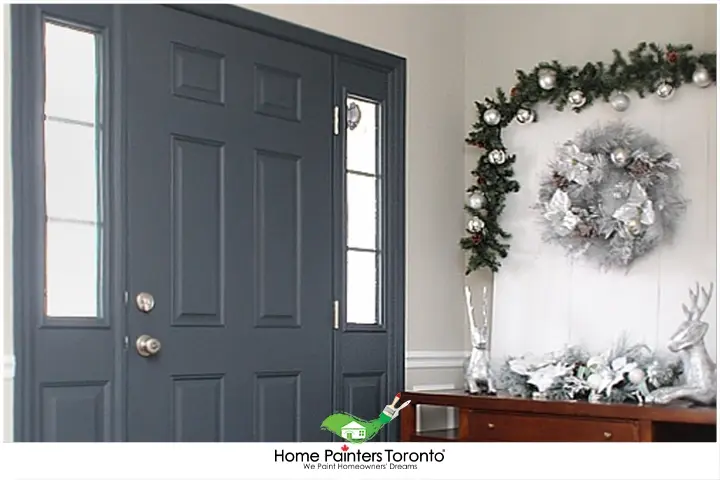
The transformative power of colour on an interior door cannot be overstated. When selecting the best colour for interior doors, consider the door’s role in your interior environment. Will it stand as an accent feature or blend seamlessly with the wall colours?
Bold and Dramatic
Opting for a bold shade can turn your door into a statement piece, a slice of artistry within the home. A deep navy blue or an energetic turquoise can interject sophistication or verve into a neutral space. The key is contrast—choosing a colour that departs sufficiently from the surrounding walls to create intentional and controlled visual tension.
Soft and Understated
For a more subdued approach, soft pastels or warm neutrals can harmonize with the existing palette, supporting a cohesive and tranquil interior. These tones can be particularly effective in spaces where the goal is to evoke restfulness, such as bedrooms or personal studies.
Dark and Sensual
In recent design trends, we’ve seen a surge in the use of dark colour palettes—charcoal greys and rich blacks bringing a dramatic flair. Applied to interior doors, these hues can contribute to a luxurious and immersive environment. Dark colours are also practical, skillfully disguising fingerprints and smudges in high-traffic areas.
Practical Considerations
Before you commit the brush to the door, there are practical elements to contemplate. Assess the condition of your door. If it is laden with imperfections, a high gloss might not be the best choice, as it tends to amplify flaws. A matte or eggshell finish can be more forgiving.
Preparation is crucial—you’ll want to ensure a clean, smooth surface to work with. Sanding, priming, and taping off hardware are preparatory steps that should not be sidestepped. Also, consider the type of paint best suited for interior doors: high-durability formulas that can withstand the everyday wear and tear of opening and closing.
Balancing Act: Aesthetics, Functionality, and Cost
In aligning aesthetics with practicality, the choice of colour and style for your door should be juxtaposed with the door’s functionality and the maintenance requirements associated with different finishes. Moreover, refreshing the colour of an interior door is a cost-effective method to update a space without the expense of a complete renovation.
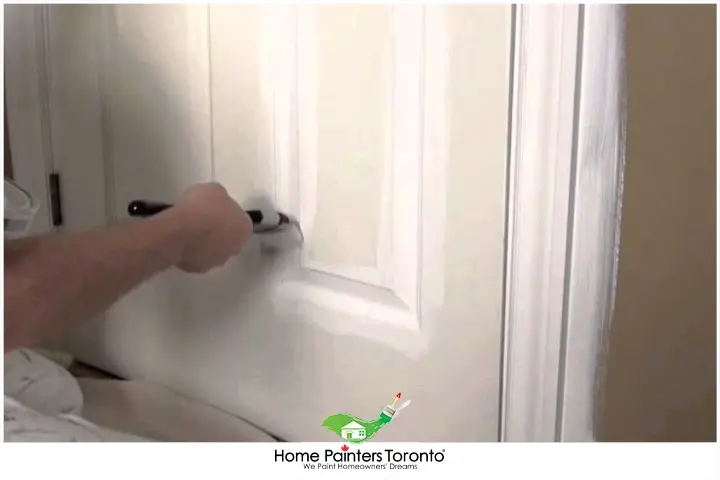
Interior Doors Styles
There’s definitely something to be said when it comes to door painting and different interior door styles. There’s actually a lot to choose from and think about when making your decision.
There are the basic hinge doors, which you typically find most people use in bedrooms or bathrooms. They’re very easy to use and install. They swing back and forth and are usually pretty with no fuss. Plus, since they’re so easily maneuvered, you have the luxury of painting them in just about any colour!
You also have the very popular sliding barn doors right now. They’re quite trendy, and people use them a lot to bring a rustic vibe to a room. There’s also bi-pass (or sliding doors) that you see in a lot of closets or smaller spaces. The same thing goes with bi-fold doors as well. You’ll also find pocket doors in some apartment buildings or older homes!
Make it pop!
We do all sorts of things in the world of interior painting in order to make our home spaces stand out. So, if you’ve never thought of interior door painting as a way to make a statement, we’re here to help you make those crucial decisions.
If you really want to add a splash of colour and make things pop, here is the chance to go bold. It’s really popular this season to think of yellow when going bold. Jasper Yellow would be fun for interior door painting in a kids’ bedroom or even a funky bathroom. Going a bit darker with your interior door painting with Slate Teal is another cool option. This bold teal would look amazing on an interior bedroom door or even on the back of a kitchen door or hallway closet!
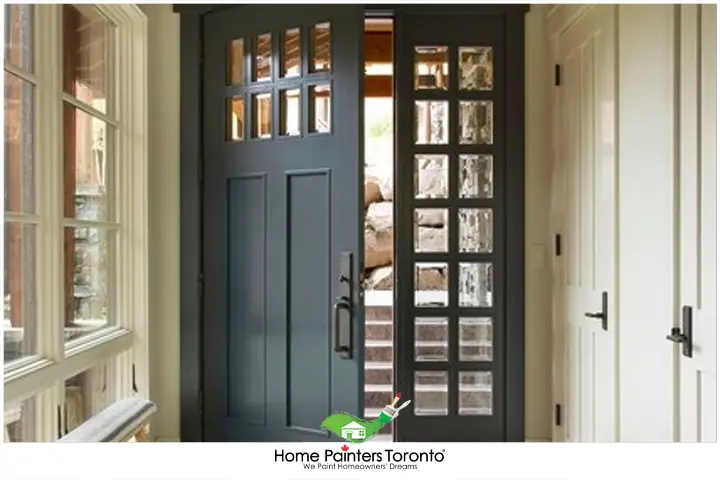
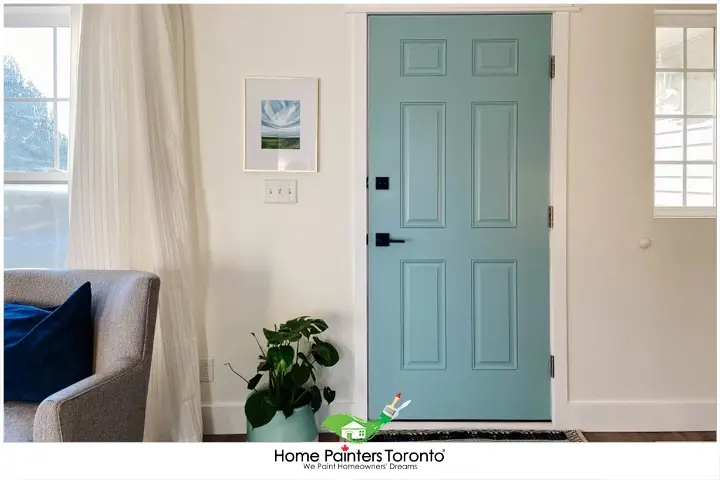
Interior door painting: Tips & tricks
- Choose your indoor door paint. We recommend Benjamin Moore or Sherwin Williams paints in a semi-gloss or satin/pearl finish as the best for interior door painting. You’ll be able to wash your door more effectively if you stay away from an eggshell finish.
- Decide how you’re going to be painting your interior door. Do you want to paint it in place or by laying it flat? There are benefits to both methods. However, leaving the interior door on its hinges means you can paint both sides at the same time.
- Make sure to clean the door before painting! Even if your door looks relatively clean, it’s better to give it a thorough scrub with soap and water prior to any door painting.
Don’t forget about your trim!
The really fun thing about playing up your new paint job is that you can also update the elements around it. That most definitely includes the trim. It can really make a new colour pop if you stop to think about the colour of your interior door trim as well.
Most traditionally, a lot of people go for a basic white or cream. This actually works really well if you’re still going more modern with your interior door painting, like Gray Shower. It’s clean, and modern and can really help to make your interior door painting stand out that much more! Don’t forget to visit our Pinterest page for all sorts of interior painting inspiration!
Summary
In conclusion, interior door painting is an opportunity to harness the synergy between form and function, offering a relatively simple way to make a significant impact on your space. As you contemplate the spectrum of stylistic and colour choices, be mindful of the harmony between your doors and the broader design vision of your home. With judicious planning and a touch of creativity, your interior doors can become conduits of style and sophistication, enhancing both the aesthetic appeal and the lived experience within your personal sanctuary.
Don’t forget about your trim!
More Interesting Blogs Related to
“Interior Door Painting: Different Styles & Updating Colour”
If you don’t have enough time yourself or are just looking for a more professional look for your interior door, call 416.494.9095 or email Brian@HomePaintersToronto.com for a FREE quote or visit our website. And don’t forget to follow us on all our social channels below!


